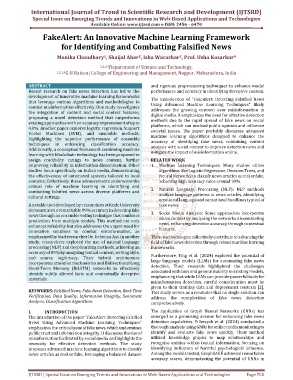Page 710 - Emerging Trends and Innovations in Web-Based Applications and Technologies
P. 710
International Journal of Trend in Scientific Research and Development (IJTSRD)
Special Issue on Emerging Trends and Innovations in Web-Based Applications and Technologies
Available Online: www.ijtsrd.com e-ISSN: 2456 – 6470
FakeAlert: An Innovative Machine Learning Framework
for Identifying and Combatting Falsified News
4
3
1
Monika Chaudhary , Shaijal Aher , Isha Wararkar , Prof. Usha Kosarkar
2
1,2,3,4 Department of Science and Technology,
1,2,3,4 G H Raisoni College of Engineering and Management, Nagpur, Maharashtra, India
ABSTRACT and rigorous preprocessing techniques to enhance model
Recent research on fake news detection has led to the performance and accuracy in identifying deceptive content.
development of innovative machine learning frameworks
The introduction of "FakeAlert: Detecting Falsified News
that leverage various algorithms and methodologies to
Using Advanced Machine Learning Techniques" likely
combat misinformation effectively. One study investigates
addresses the growing concern over misinformation in
the integration of content and social context features,
digital media. It emphasizes the need for effective detection
proposing a novel detection method that outperforms
methods due to the rapid spread of fake news on social
existing approaches with an accuracy improvement of up to
platforms, which can mislead public opinion and influence
4.8%. Another paper explores logistic regression, Support
societal issues. The paper probably discusses advanced
Vector Machines (SVM), and ensemble methods,
machine learning algorithms designed to enhance the
highlighting the superior performance of ensemble
accuracy of identifying fake news, combining content
techniques in enhancing classification accuracy.
analysis with social context to improve detection rates and
Additionally, a conceptual framework combining machine
mitigate the impact of misinformation online.
learning with blockchain technology has been proposed to
assign credibility ratings to news content, further RELATED WORK
improving reliability in information dissemination. Other 1. Machine Learning Techniques: Many studies utilize
studies focus specifically on Indian media, demonstrating algorithms like Logistic Regression, Decision Trees, and
the effectiveness of automated systems tailored to local Neural Networks to classify news articles as real or fake,
contexts. Collectively, these advancements underscore the achieving high accuracy rates around 99%.
critical role of machine learning in identifying and 2. Natural Language Processing (NLP): NLP methods
combatting falsified news across diverse platforms and
analyze language patterns in news articles, identifying
cultural settings.
emotional language and sensational headlines typical of
A notable tool developed by researchers at Keele University fake news.
demonstrates a remarkable 99% accuracy in detecting fake
3. Social Media Analysis: Some approaches incorporate
news through an ensemble voting technique that combines
social context by analyzing the networks disseminating
predictions from multiple models. This method not only
news, enhancing detection accuracy through contextual
enhances reliability but also addresses the urgent need for
features.
innovative solutions to combat misinformation, as
emphasized by lead researcher Dr. Uchenna Ani. In another These methodologies collectively contribute to advancing the
study, researchers explored the use of natural language field of fake news detection through robust machine learning
processing (NLP) and deep learning methods, achieving an frameworks.
accuracy of 89% by analyzing textual content, writing style,
Furthermore, Ying et al. (2024) explored the potential of
and source legitimacy. Their hybrid architecture
large language models (LLMs) for automating fake news
incorporates attention mechanisms and Bidirectional Long
detection. Their research highlighted the challenges
Short-Term Memory (BiLSTM) networks to effectively
associated with bias and generalizability in existing models,
identify subtly altered facts and contextually deceptive
emphasizing that while LLMs can provide powerful tools for
materials.
misinformation detection, careful consideration must be
given to their training data and deployment contexts [2].
KEYWORDS: Falsified News, Fake News Detection, Real-Time This study serves as a reminder that no single solution can
Verification, Data Quality, Information Integrity, Sentiment
address the complexities of fake news detection
Analysis, Classification Algorithms
comprehensively.
I. INTRODUCTION The application of Graph Neural Networks (GNNs) has
The introduction of the paper "FakeAlert: Detecting Falsified emerged as a promising avenue for enhancing fake news
News Using Advanced Machine Learning Techniques" detection capabilities. Pilkevych et al. (2024) conducted a
emphasizes the critical issue of fake news, which undermines thorough analysis using GNNs for online media monitoring to
public trust and information integrity. It discusses the rise of identify and evaluate fake news quickly. Their method
misinformation facilitated by social media and highlights the utilized knowledge graphs to map relationships and
necessity for effective detection methods. The study recognize entities within textual information, focusing on
proposes advanced machine learning algorithms to classify identifying indicators of harmful psychological influence.
news articles as real or fake, leveraging a balanced dataset Among the models tested, GraphSAGE achieved remarkable
accuracy scores, demonstrating the potential of GNNs in
IJTSRD | Special Issue on Emerging Trends and Innovations in Web-Based Applications and Technologies Page 700

